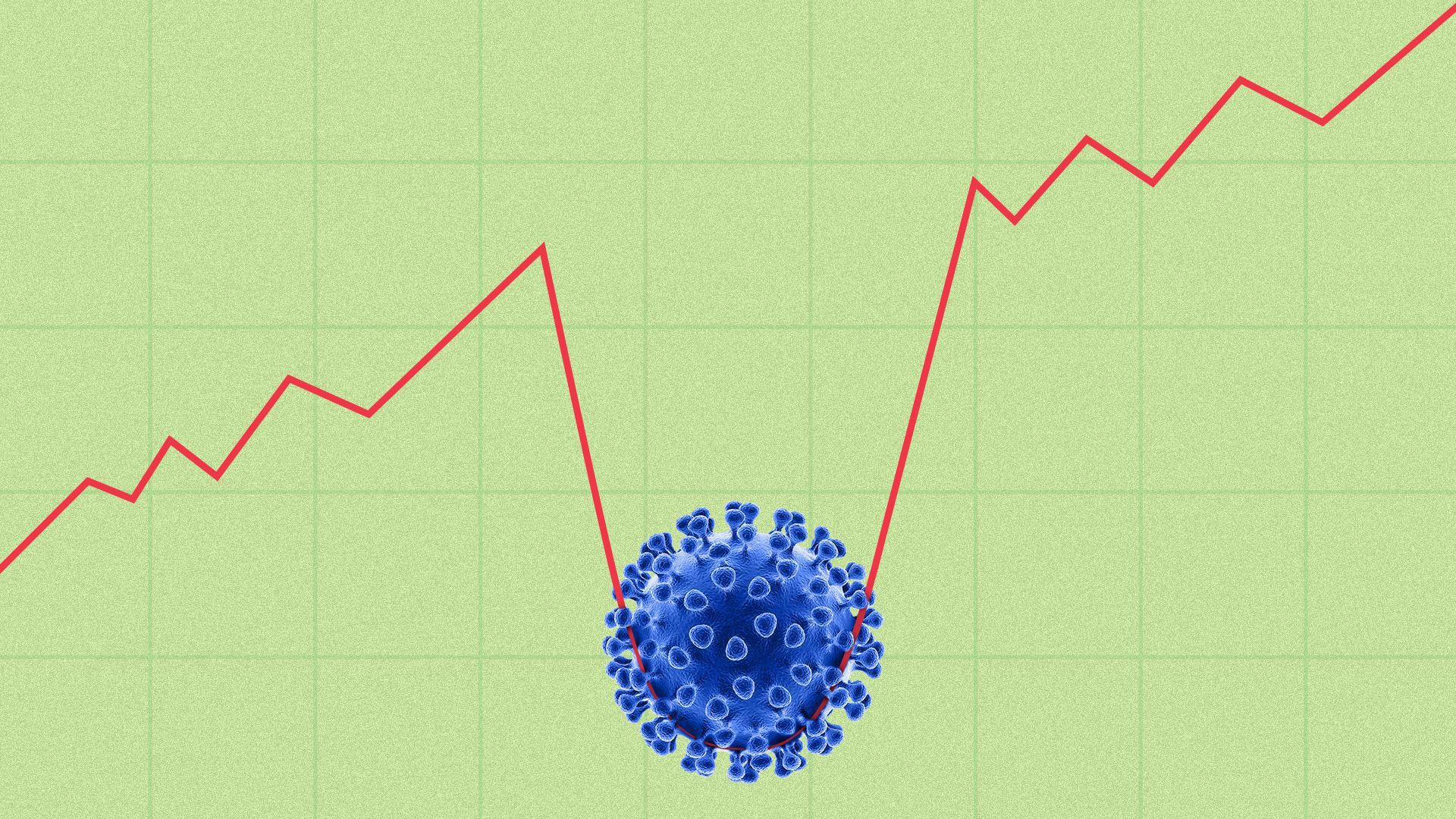| | | | | | | Presented By Aon | | | | Axios Markets | | By Kate Marino ·Oct 11, 2021 | | 👋 Howdy Markets crew! Hope you had a great weekend. ⚡️ Heads up ... President Biden on Friday became the first president to issue an official proclamation commemorating Indigenous Peoples Day (it's today!). Also, retailers are kind of over Columbus Day sales... 🎥 If you didn't catch "Axios on HBO" on Sunday night, check out this clip of Dan Primack's interview with Labor Secretary Marty Walsh. - They talk about the disappointing Friday jobs report, the labor mismatch, and a lot more.
✉️ Today's newsletter is 1,228 words, 5 minutes. | | | | | | 1 big thing: Earnings season is here |  | | | Illustration: Aïda Amer/Axios | | | | The third-quarter earnings season is going to be telling. We all expected monster numbers across the board out of Q2 results — but this time around, some companies will distinguish themselves more than others for how they've managed the escalating supply chain headaches and effects of the Delta variant, Axios' Hope King writes. Why it matters: The blistering pace of economic growth is expected to have slowed in Q3. That will show up earnings, which began trickling out last week. - Yes, but: Growth will still be substantial compared to 2020, as well as to pre-pandemic 2019 earnings.
By the numbers: Third quarter median EPS in the S&P 500 is expected to reach $48.32, an 8.3% decline from the second quarter, according to S&P Capital IQ consensus estimates. - That would represent a 24.5% growth from last year, compared to the 88.5% surge in Q2 2021 from the depths of the pandemic.
Context: The second quarter's year-over-year S&P earnings growth was the largest since Q4 2009 when the economy was climbing out of the financial crisis, according to FactSet. The big picture: Since 2009, the S&P 500 has beat analyst EPS growth estimates in all but one quarter (Q2 2020, not surprisingly). But it faces an uphill climb to beat in Q3, Sam Stovall, CIO at CFRA Research, tells Axios. - In a signal of the evolving challenges, economists have moved their GDP estimates lower over the course of the quarter.
State of play: The energy and materials sectors are expected to drive earnings gains, while travel, leisure and hospitality will be a drag on growth due to the impact of the Delta variant, according to Anastasia Amoroso, chief investment strategist at iCapital. What we're watching: Margins. One of the big questions of the moment is how much businesses are able to raise prices (Bed Bath & Beyond said earlier in the month that it didn't act fast enough — and its stock tanked). - Inventory levels, too. Consumer demand has eaten away at stockpiles that were already low due to supply chain slowdowns. Quarter-end stats will signal how much companies may have to spend in Q4 and beyond to restock.
- Semiconductor reports will offer clues about the Q4 outlook and how quickly the world will rebound from the chip shortage, Amoroso adds.
The bottom line: While 24.5% growth may feel like a buzzkill after 88.5% in Q2, it's still nearly triple the 9% to 10% that's typical of the S&P 500. - "We're continuing to see the economy normalize, post the pandemic, and in this quarter, in particular, we managed to persevere through the Delta variant," says Amoroso.
|     | | | | | | Bonus chart: Still looking strong |  Data: S&P Dow Jones Indices division; Chart: Axios Visuals |     | | | | | | 2. Catch up quick | | In the wake of Chinese property developers China Evergrande and Fantasia Holdings skipping out on debt payments, global investors are braced for more defaults in the $5 trillion of debt that fueled China's real estate boom. (WSJ) Economists at Goldman Sachs cut their forecasts for U.S. GDP growth this year and next, in light of delayed recovery in consumer spending and continuing supply problems for items like semiconductors. (Bloomberg) With home prices soaring rapidly, properties are increasingly being appraised below their sale prices, causing deals to fall apart. (WSJ) KKR founders Henry Kravis and George Roberts will step down from their positions as co-CEOs but will remain with the firm as executive co-chairmen. (Reuters) |     | | | | | | A message from Aon | | New risks require better decisions | | |  | | | | In the wake of COVID-19, Aon surveyed 800 leaders across the U.S., the EU, the United Kingdom and Canada to learn how the experience has changed how companies integrate risk assessment, data and expertise to mitigate volatility. Here's what they said. | | | | | | 3. Women and retirees |  Data: U.S. Bureau of Labor Statistics; Chart: Axios Visuals The silver lining in Friday's mediocre jobs report was this milestone: The unemployment rate dropped below 5% for the first time since the pandemic sent workers home in droves. - Yes, but: Part of what pushed it down was shrinking labor force participation.
By the numbers: The labor force, which includes anyone who either has a job or is actively looking for one, ticked down by 183,000 in September (those who have stopped looking for jobs are not counted in the labor force — or in the unemployment rate). - The labor force participation rate has stubbornly stuck in the 61.5% area since June 2020, a recovery of less than half its pandemic drop.
Why it matters: September's decline signals that some people are giving up on finding jobs (at least for now), at a time when there are still 5 million fewer people working than there were in February 2020. Two reasons: Women and recent retirees. - The participation rate for women, often primary caregivers for kids or elderly family members, slipped again in September, to 57.1% (the rate for men went up, to 70%).
- And more — mostly affluent — people near retirement age are calling it quits early, surveys and data show. One driver is simply that they can afford it, thanks to significant growth in asset values like stocks and real estate over the last year and a half, Tony Roth, CIO at Wilmington Trust, tells Axios.
The bottom line: The irony, of course, is that the Federal Reserve has been waiting for more job growth before pulling back on its emergency market support — but that support may be contributing to the lack of job growth among workers close to retirement age, Roth adds. |     | | |  | | | | If you like this newsletter, your friends may, too! Refer your friends and get free Axios swag when they sign up. | | | | | | | | 4. Oil and gas producers are still holding back |  Data: Baker Hughes; Chart: Axios Visuals Oil and gas prices have skyrocketed this year as energy demand rushes back — but U.S. producers aren't activating their dormant rigs in droves. Driving the news: The U.S. added five rigs last week and a total of 30 over the past four weeks, according to Baker Hughes. - But the current count of 533 is far off the roughly 790 from just before the pandemic.
Why it matters: Adding to the supply would help keep a lid on the price growth. Rising oil and gas prices translate to higher electricity and gasoline costs, and weigh on consumer spending. - But U.S producers are exercising some caution. Some have been burned in the past when they ramped up production only to have prices move down to unprofitable levels.
- And pressure from investors, governments and the broader population to focus on the transition to renewables has some of the larger oil companies directing more funds to clean tech.
What's happening: Thanks to a supply-and-demand imbalance, oil has doubled since its low last year and natural gas is up about 130%. What to watch: Whether producers remain cautious in the weeks and months to come, or decide to open the spigot faster — especially as winter heating needs approach. |     | | | | | | 5. What we're watching this week |  | | | Illustration: Eniola Odetunde/Axios | | | | We'll get our hands on a slew of fresh inflation data this week. The Consumer Price Index for September is out Wednesday morning, followed by the Producer Price Index on Thursday. - Watch for the relationship between the two.
Why it matters: We've already gotten hints that price growth is accelerating again, after cooling slightly mid-summer. - Count 'em up: The Personal Consumption Expenditures price index grew more than expected last month, and the pricing indexes in the ISM's manufacturing and services reports both showed businesses forking over more cash for raw materials.
Yes, but: Some commodities — like crops and lumber — have retrenched, and that may show up in the PPI reading, Wilmington Trust's Roth says. The intrigue: Watch for the PPI's rate of growth compared to the CPI. - Let's break that down. PPI measures input costs to producers, while CPI is a gauge of the prices that consumers pay.
- If PPI is rising faster than CPI, it means companies are losing their pricing power, Roth notes.
The bottom line: As Hope wrote earlier in this newsletter, businesses' pricing power will have implications for earnings (and for our pocketbooks). |     | | | | | | A message from Aon | | How executives view the economy in the wake of COVID-19 | | |  | | | | For businesses tested by the COVID-19 pandemic, their resiliency has spurred overwhelming economic optimism. Find out why nearly 90% of C-suite leaders and executives surveyed by Aon project business conditions to strengthen in the next year. | | |  | | It'll help you deliver employee communications more effectively. | | | | | | Axios thanks our partners for supporting our newsletters. If you're interested in advertising, learn more here.
Sponsorship has no influence on editorial content. Axios, 3100 Clarendon Blvd, Suite 1300, Arlington VA 22201 | | | You received this email because you signed up for newsletters from Axios.
Change your preferences or unsubscribe here. | | | Was this email forwarded to you?
Sign up now to get Axios in your inbox. | | | | Follow Axios on social media:    | | | | | |












No comments:
Post a Comment